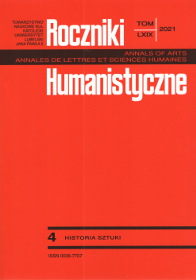The Hermeneutics of Medieval Art: Own or Loaned? An Attempt to Apply the Procedures of Philosophical Hermeneutics in Art Research
Abstract
Max Imdahl’s hermeneutics distinguishes seeing that recognizes an iconographic subject and one that sees a specific structure of an image. Godfried Böhme’s hermeneutics is a transposition of the visual medium to the pictorial medium, while finding what both have in common, i.e. Bildlichkeit. Oskar Bätschmann’s hermenutics rejects the reductions done by iconology to a work of art and seeks to discover what the work of art reveals by itself. These three hermeneutics direct the researcher’s attention towards the unique, specific structure of the work, irreducible to discourse. The study of medieval art requires going beyond the strict visual structure. An attempt was made to apply procedures inherent in the philosophical hermeneutics of Hans-Georg Gadamer. The basis of this hermeneutics is the existence of pre-cognition, which is the actual knowledge of the work, and the use of language that excludes the unreflective use of codes. A circular research path leads from pre-recognition to tradition. However, in the process of studying medieval art, the reference of a work to tradition cannot be made straight away. A given work must be placed against the horizon which is the reality surrounding it, namely in relation to the liturgical, exegetical, spiritual and theological-political horizons. The spiral line runs then towards the horizon, spiraling into moments of the tradition along the timeline. A confrontation with tradition is finding the sense of belonging, a moment in tradition, a moment of commonality of the basic contents of both the work and the reality, which both belong to tradition. Applying the notion of a sense of belonging will not result in the loss of its own hermeneutics of art in favor of hermeneutics appropriate to the content of tradition.
References
Bätschmann, Oskar. Einführung in die kunstgeschichtliche Hermeneutik. Die Auslegung von Bildern. Darmstadt Wissenschaftliche Buchgesselschaft, 2001.
Bätschmann, Oskar. „Beiträge zu einem Übergand von der Ikonologie zur kunstgeschichtlichen Hermeneutik”. Bildende Kunst als Zeichensystem. Band 1: Ikonographie und Ikonologie. Theorien-Entwicklung-Probleme. Verlag DuMont, 1979, ss. 460-484.
Boehm, Gottfried. „Zu einer Hermeneutik des Bildes”. Seminar: Die Hermeneutik und die Wissenschaft, red. Hans-Georg Gadamer i Gottfried Boehm, Suhrkamp, 1978, ss. 444- 471.
Bryl, Mariusz. „Płaszczyzna ogląd absolut. Inspiracje hermeneutyczne we współczesnej historii sztuki”. Artium Quaestiones, t. 6, 1993, ss. 55-84.
Bryl, Mariusz. „[Rozdz. VIII] Hermeneutyki w historii sztuki między alternatywą a przyswojeniem”. Suwerenność dyscypliny. Polemiczna historia stuki od 1970 roku. Wydawnictwo Naukowe UAM, 2008 , ss. 433-494.
Das Evangeliar Ottos III Clm 4453 der Bayerischen Staatsbibliothek München, red. Florentine Mütherich i Karl Dachs, Prestel, 2001.
Fajt, Jiří, i Štěpánka Chlumská. Čechy a střední Evropa 1200-1550. Dlouhodobá expozice sbírky starého umění Národní galerie v Praze v klášteře sv. Anežky České. Národní Galerie, 2006.
Haake, Michał. „Jednostka wobec historii. Portret generała Henryka Dembińskiego Henryka Rodakowskiego”. Artium Quaestiones, t. 12, 2001, ss. 25-84.
Haake, Michał. „Obraz w kole rozumienia”. Artium Quaestiones, t. 20, 2009, ss. 141-170.
Haake, Michał. „Powołanie Mateusza Caravaggia. Studium z hermeneutyki obrazu”. Artium Quaestiones, t. 18, 2007, ss. 37-115.
Imdahl, Max. Giotto, Zur Frage der ikonischen Sinnstruktur. Carl Friedrich von Siemens Stiftung, 1979 (pol. „Giotto. Z zagadnień ikonicznej struktury sensu”. Tłum. Tadeusz Żuchowski. Perspektywy współczesnej historii sztuki. Antologia przekładów „Artium Quaestiones”, red. Mariusz Bryl, Piotr Januszewski, Piotr Piotrowski i Wojciech Suchocki, Wydawnictwo Naukowe UAM, 2009, ss. 111-138.
Imdahl, Max. „Kontingenz, Komposition, Providenz. Zur Anschauung eines Bildes von Giotto”. Anschauung als ästhetische Kathegorie: Neue Hefte für Philosophie, t. 19/19, 1980, ss. 151-177.
Imdahl, Max. „Über eine narrative Strukturen in den Arenafresken Giottos”. Geschichte – Ereignis und Erzählung, red. Reinhart Koselleck i Wolf-Dieter Stempel, (Poetik und Hermeneutik V), Verlag Fink, 1973, ss. 155-173.
Jungmann, Josef Andreas. Missarum solemnia. Eine genetische Erklärung der römischen Messe. Bd. 2, Herder, 1952.
Martimort, Aimé-Georges. La Chiesa in preghiera. II. Eucaristia, red. wyd, włoskiego Adelio Biazzi, Queriniana, 1985.
Mayr-Harting, Henry. Ottonian Book Illumination: An Historical Study. Part I: Themes, Harvey Miller Brepols 1999, pp. 1598-159.
Meyer, Hans Bernhard. Eucharistie. Geschichte, Theologie, Pastoral. Friedrich Pustet, 1989.
Pešina, Jaroslav. Mistr Vysebrodského cyklu. Odeon, 1982.
Skubiszewski, Piotr. „Programy obrazowe kielichów i paten romańskich”. Rocznik Historii Sztuki, t. 13, 1981, ss. 77-81.
Scattola, Merio. Teologia polityczna. Tłum. Paweł Borkowski, Instytut Wydawniczy PAX, 2011.
Tabor, Dariusz. „Od lectio divina do dwóch sensów Pisma. Refleksy cysterskiej egzegezy w Psałterzu trzebnickim IF 440”. Dzieje i kultura cystersów w Polsce 2, red. Marcin Starzyński i Dariusz Tabor, Wydawnictwo Uniwersytetu Papieskiego Jana Pawła II w Krakowie, 2018, ss. 179-194.
Tabor, Dariusz, „Psałterz trzebnicki: między egzegezą a duchowością”. Cysterki w dziejach i kulturze ziem polskich, dawnej Rzeczypospolitej i Europy Środkowej. Materiały z siódmej Międzynarodowej Konferencji Cystersologów, Trzebnica 18-21 września 2002, red. Andrzej Marek Wyrwa, Antoni Kiełbasa i Józef Swastek, Wydawnictwo Poznańskie, 2004, ss. 108-120.
Copyright (c) 2021 Roczniki Humanistyczne

This work is licensed under a Creative Commons Attribution-NonCommercial-NoDerivatives 4.0 International License.





